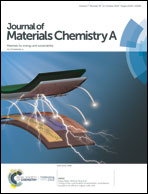Charge transfer modulation in layer-by-layer-assembled multilayered photoanodes for solar water oxidation†
Abstract
Recent years have witnessed a rise in the construction of transition metal chalcogenide (TMS)-based heterostructured photocatalysts in terms of their excellent light absorption and suitable energy level alignment. Nevertheless, controllable modulation of photoinduced charge separation/transfer toward target active sites for photoredox catalysis still constitutes an enduringly challenging issue. Herein, tailor-made negatively charged mercaptoacetic acid (MAA)-capped CdX@MAA (X = Se, Te, S) quantum dot (QD) and positively charged ultra-thin branched poly-ethyleneimine (BPEI) layer building blocks were alternately assembled on the hierarchically ordered TiO2 nanotube array (NP-TNTA) framework for general electrostatic layer-by-layer (LbL) assembly of spatially multilayered NP-TNTAs/(BPEI/CdX QDs)n (X = Se, Te, S) photoanodes. The ultra-thin BPEI polymer layer integrated in-between the interface of CdX QDs functions as a cascade hole transfer channel for efficiently extracting the holes photoexcited over neighboring CdX QD layers, and simultaneously, alternately deposited CdX QD layers serve as an efficacious photosensitizer for constructing directional electron flow channels. The unique integration mode and intimate interfacial interaction endowed by LbL assembly render the well-defined NP-TNTAs/(BPEI/CdX QDs)n multilayered heterostructures a high-efficiency photoanode toward photoelectrochemical (PEC) water splitting under both simulated solar and visible light irradiation, greatly outperforming the single and binary counterparts on account of in situ generation of two spatially separated charge transfer channels, ultimately synergistically boosting the separation efficiency and prolonging the lifetime of charge carriers. Our work would open up new frontiers for strategically mediating the interfacial charge transfer and advancing rational construction of heterostructured photocatalysts for solar energy conversion.

- This article is part of the themed collection: 2019 Journal of Materials Chemistry A HOT Papers


 Please wait while we load your content...
Please wait while we load your content...